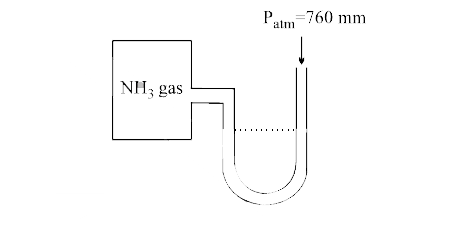A open ended mercury manometer is used to measure the pressure exerted by a trapped gas as shown in the figure. Initially manometer shows no difference in mercury level in both columns as shown in diagram.

After sparking 'A' dissociates according to following reaction
A(g)→B(g)+3C(g)
If pressure of Gas "A" dissociates to 0.9 atm, then (Assume temperature to be constant and is 300 K)
Total pressure increased by 1.3 atm
Total pressure increased by 0.3 atm
Total pressure increased by 22.3 cm of Hg
Difference in mercury level is 228 mm
The correct Answer is:ABD
PT=(1+3×)=1+3×0.1=1.3 atm.
Δ=0.3 atm or 76×0.3cm of Hg
or 760×0.3mm of Hg
Topper's Solved these Questions
- GASEOUS STATE BOOK - ERRORLESS CHAPTER - GASEOUS STATE EXERCISE - JEE SECTION (Reasoning type questions)
3 Videos
- GASEOUS STATE BOOK - ERRORLESS CHAPTER - GASEOUS STATE EXERCISE - JEE SECTION Comprehension type question (Passage-I)
2 Videos
- GASEOUS STATE BOOK - ERRORLESS CHAPTER - GASEOUS STATE EXERCISE - JEE SECTION (Only one choice answer)
44 Videos
- ENVIRONMENTAL CHEMISTRYBOOK - ERRORLESS CHAPTER - ENVIRONMENTAL CHEMISTRYEXERCISE - CRITICAL THINKING (Objective question )
16 Videos
- GENERAL ORGANIC CHEMISTRYBOOK - ERRORLESS CHAPTER - GENERAL ORGANIC CHEMISTRYEXERCISE - Matrix Match type questions
4 Videos
Similar Questions
A manometer attached to a flask contains NH3 gas have no difference in mercury level initially as shown in diagram.After the sparking into the flask, it have difference of19 cm in mercury level in two columns.Calculate % dissciation of ammonia

View SolutionAmmonium hydrogen sulphide dissociated according to the equation,
NH4HS(s)⇔NH3(g)+H2S(g). If the observed pressure of the mixture is 1.12 atm at 106∘C, what is the equilibrium constant Kp of the reactions ?
View Solution
Knowledge Check
An open ended mercury mnometer is used to measure the pressure exerted by a trapped gas as shown in the figure. Initially manometer shows no difference in mercury level in both columns as shown in diagram.

After sparking A dissociates according to following reaction:
2A(g)→3B(g)+2C(g) ltbr> If pressure of Gas A decreases to 0.8 atm. Then:
(Assume temperature to be constant at 300K)Atotal pressure increased by 1.3 atmBtotal pressure increased by 0.3 atmCtotal pressure increased by 22.3 cm of HgDdifference in mercuty level is 228mmA manometer attached to a flask contains with ammonia gas have no difference in mercury level initially as shown in diagram. After sparking into the flask, ammonia is partially dissociated as 2NH3 (g)→N2 (g)+3H2 (g) now it have difference of 6 cm in mercury level in two columns, what is partial pressure of H2 (g) at equilibrium?
 A9 cm HgB18 cm HgC27 cm HgDNone of these
A9 cm HgB18 cm HgC27 cm HgDNone of theseAn experiment is done as shown in diagram then final pressure after stop cock is opened.
[Assume reaction : NH3(g)+HCl(g)→NH4Cl(s) ]
 A3 atmB13 atmC1 atmD1.5 atm
A3 atmB13 atmC1 atmD1.5 atm
A tube of length 50 cm is containing a gas in two secitons separated by a mercury column of length 10cm as shown in figure. The tube's open end is just inside the Hg surface in container, find pressure of gas in upper section. [Assume atmospheric pressure = 75 cm of Hg column]

View SolutionCalculate the volume percent of chlorine gas at equilibrium in the dissociation of PCl5(g) under a total pressure of 1.5 atm. The Kp for its dissociation =0.3.
View SolutionSolid ammonium carbonate dissociates according to the reaction
NH2COONH4(s)⇔2NH3(g)+CO2(g)
At 298 K, the total pressure of the gases in equilibrium with the solid is 0.116 atm. Calculate Kp.
View SolutionAmmonium hydrogen sulphide dissociates according to the equation :
NH4HS(s)⇔NH3(g)+H2S(g)
The total pressure at equilibrium at 400 K is found to be 1 atm.The equilibrium constant Kp of the reaction is :
View SolutionGas A (1 mol) dissociates in a closed rigid container of volume 0.16 lit. as per following reaction.
2A(g)→3B(g)+2C(g) If degree of dissociation of A is 0.4 and remains constant in entire range of temperature then the correct P us T graph is: [Given R=0.08 lit-atm/mol/K]
View Solution
